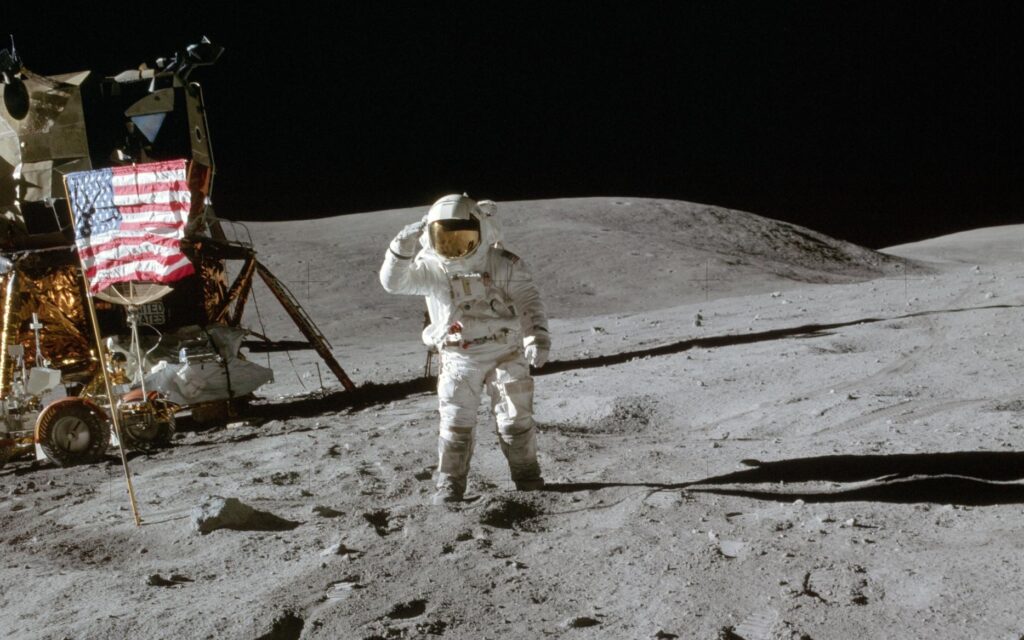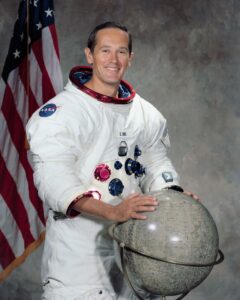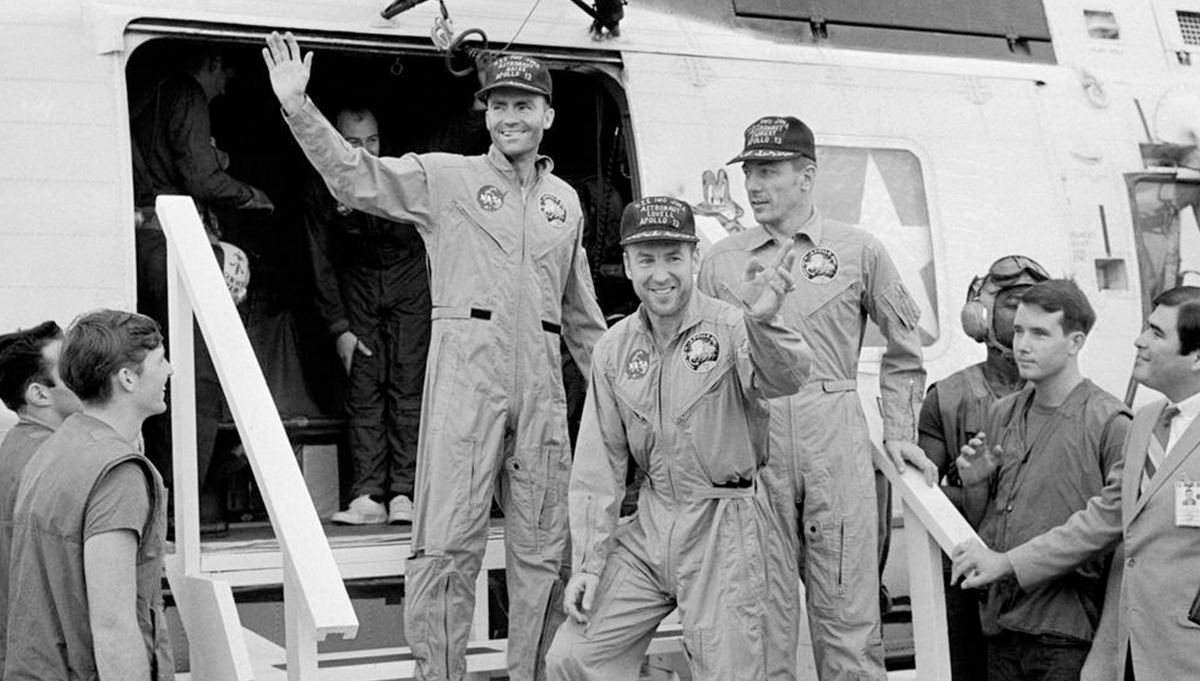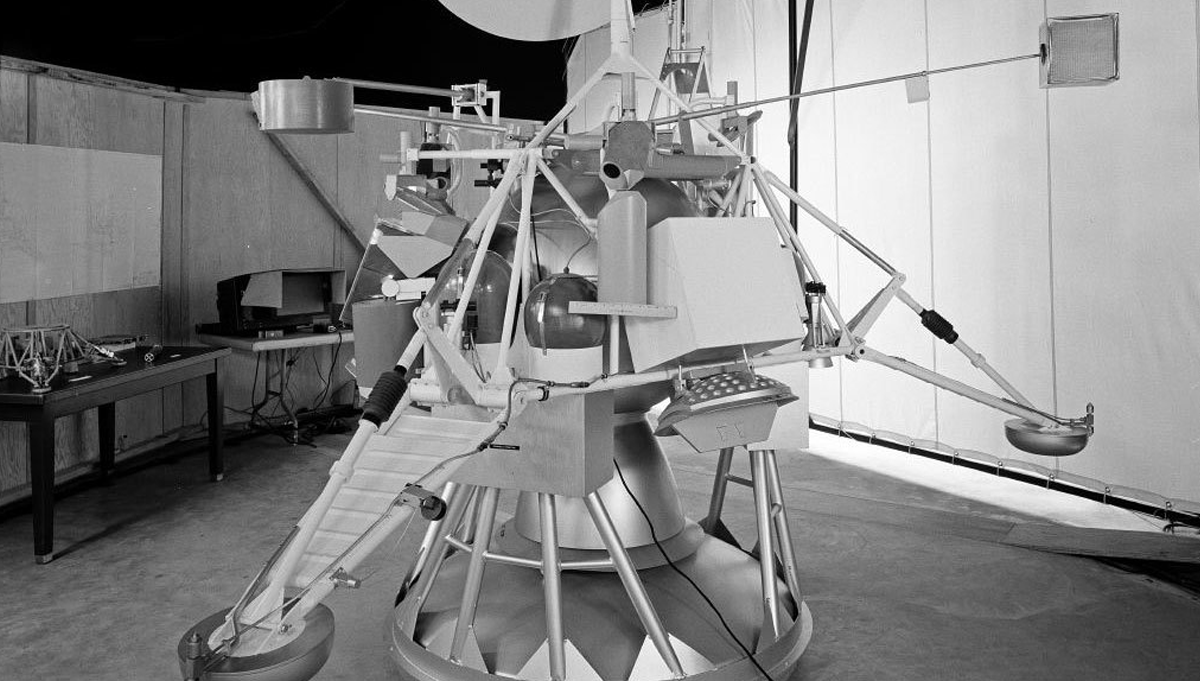
Apollo 11 CapCom Charles M. Duke, Jr., left, with astronauts James A. Lovell, Jr., center, and Fred W. Haise, Jr. during the first human lunar landing on July 20, 1969. Photo Credit: NASA
Duke talks Armstrong and Aldrin through communications issues, alarms, and a dwindling fuel supply to help them reach the lunar surface.
On a clear day in the early 1950s, Charles M. Duke, Jr., a student at Lancaster High School, was riding in his friend’s convertible. Looking up, Duke saw a contrail, a rarity in the skies over Charlotte, North Carolina, that early in the jet age.
“Gosh, it’d be nice to make a contrail. I wonder what that’d be like?” Duke thought. “And I started dreaming about flying airplanes then.”
It wasn’t long until Duke was flying. At the U.S. Navel Academy, Duke was a passenger several times in the N3N, a bright yellow, tandem-seat, open cockpit, bi-wing seaplane. Duke found that the motion sickness he felt aboard ships was gone in the skies, even in a plane as raucous as the “Yellow Bird.”
“I was hooked from that moment on,” Duke recalled in an oral history. When he graduated, he volunteered for the U.S. Air Force. After earning a Master of Science degree in Aeronautics from the Massachusetts Institute of Technology, he soon made his way to the Air Force Test Pilot School at Edwards Air Force Base, California.
Duke was selected to be a NASA astronaut in April 1966. He played an instrumental role in sorting out instability issues with the ascent engine of Apollo’s Lunar Module. “That’s a critical engine. I mean, if it didn’t work, you were going to either crash on the Moon or [be] trapped on the Moon,” Duke recalled.
Duke’s familiarity with the lunar module was an asset when he served on the support crew for Apollo 10. He helped develop the crucial activation and checkout procedures the astronauts used when they entered the lander for the first time at the Moon and separated from the command module. He also served as Capsule Communicator (CapCom) for the portion of the mission in which the crew made the first orbits around the Moon in the lunar module and returned to the command module for the critical rendezvous.
“I probably had the most experience of any of the astronauts who were not on a crew in the lunar module,” Duke said. Shortly after, Apollo 11 astronauts Neil A. Armstrong and Edwin E. “Buzz” Aldrin, Jr. approached Duke. “ ‘Charlie, you know, we’d like you to do activation and checkout for us for the landing.’ And I said, ‘Man, that’d be a great honor. I’d love to do it.’ And, of course, that’s what I did,” Duke recalled.
The afternoon of July 20, 1969—55 years ago this month—was tense. NASA had worked the better part of a decade to reach this moment. Armstrong and Aldrin undocked the lunar module from the command module at 1:44 p.m ET.
Duke: Eagle, Houston. We see you on the steerable. Over.
Armstrong: Roger. Eagle is undocked.
Duke: Roger. How does it look, Neil?
Armstrong: The Eagle has wings.
Duke: Roger.
Armstrong: Looking good.
“We had trained for a couple of months to get as perfect as we could on this landing procedure,” Duke said, in a NASA video. “As we started the actual landing sequence, things started to go not quite right.”

This image was taken during separation of the Lunar Module and the Command Module during and the LM’s descent to the lunar surface. Photo credit: NASA
The first problems were with communications. Armstrong had to reorient the spacecraft multiple times during the descent to reestablish contact with Mission Control through the lunar module’s high-gain antenna. At times, Houston relayed communications via Michael Collins, who was orbiting the Moon alone in the command module. It was Collins who told Armstrong and Aldrin they had been given the “go” for a powered descent.
Next came a series of master alarms. 1201 and 1202.
“The master alarm came on. The computer says [1202], which was an alarm code,” Duke recalled. “And I had not a clue what that was. And I [thought] ‘Oh, the mission is over. We got to abort.’ But the guidance [officer], Steve Bales, said, ‘we’re go, flight.’ As we continued down, we continued to have these alarm codes.”
Earlier in the landing, Armstrong, looking at landmarks he had identified on the lunar surface before the mission, knew they were appearing approximately 3 seconds earlier than expected. This indicated that Apollo 11 would land about 3 miles beyond the target site.
“When Neil pitched over to see the landing site for the first time, we had him targeted into a big boulder field, and it was not suitable for landing,” Duke recalled. “He had to level off at about 400-500 feet above the Moon and fly horizontally for about a mile or more. Then slow down his forward velocity, then start down. Well, all that took a lot of fuel. So, now, we’re getting a fuel problem.”
When Duke said, “Eagle, 60 seconds,” the normally active Mission Control center fell silent. The lunar lander now had less than 60 seconds of fuel remaining for a controlled landing, and the call to abort was less than a minute away. Duke’s next call, “Eagle, 30 seconds,” amped up the tension. Armstrong was silent.

Apollo 11 Commander Neil Armstrong working at an equipment storage area on the lunar module. This is one of the few photos that show Armstrong during the moonwalk. Photo Credit: NASA
“The whole mission control room was just holding our breath, literally. I had never felt such tension in mission control. I’d been in there on a Gemini flight. I’d been CapCom on Apollo 10. But this was, by far, the most tension I had ever experienced in Mission Control,” Duke said.
“Well, about 13 seconds later, according to my stopwatch, I heard Buzz Aldrin say, ‘Contact. Engine stop.’ So, we knew they were on the ground, hopefully right side up. And then there was a pause. And Neil came back, in such a cool manner.”
“Tranquility base, here. The Eagle has landed.”
“I was so excited. And my response came out first, ‘Roger, Twan…’ And I knew that wasn’t right. So, I corrected it mid-word. ‘Tranquility. We copy you on the ground. You got a bunch of guys about to turn blue. We’re breathing again. Thanks a lot!’ ”
“We broke into cheers. But the spacecraft was still at a critical point. Gene Kranz, the Flight Director, got us back to focus right away, because if we had hit that ground and sprung a leak, we had to be able to lift off right away. So, everybody was checking their systems and making sure the spacecraft was safe,” Duke said.
After those checks were complete, NASA switched crews at Mission Control. Following a press conference, Duke went home. At about 10:51 p.m., Armstrong began descending a ladder to the lunar surface.
“I watched the moonwalk from my living room with my young kids and my wife,” Duke said.

Astronaut Charles M. Duke Jr., Apollo 16 lunar module pilot, salutes the United States flag during the mission’s first extravehicular activity (EVA), on April 21, 1972. Stone Mountain reaches five-sixths across the photo in background. The Lunar Module (LM) and Lunar Roving Vehicle (LRV) are in the background. Photo Credit: NASA
On April 16, 1972, Duke launched aboard Apollo 16, with Commander John Young, and Command Module Pilot Ken Mattingly. During the mission, less than 20 years after he rode in his friend’s convertible and wondered what it would be like to make a contrail in the sky, Duke navigated the lunar surface, sitting beside Young as he drove NASA’s Lunar Roving Vehicle on the Moon.
To learn more about Apollo 11, Apollo 16, and the program that landed humans on the Moon, see APPEL KS’s Apollo Era Resources page.










